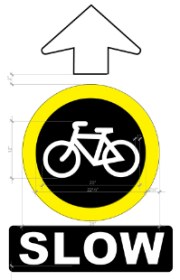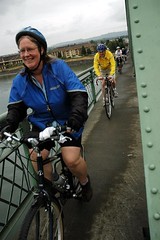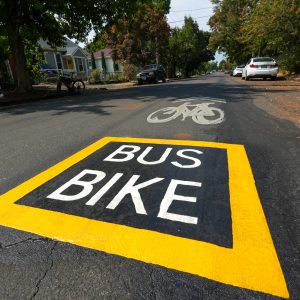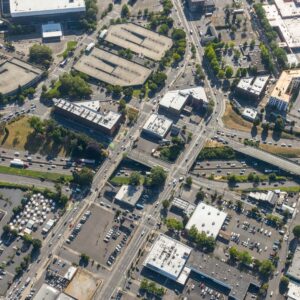
several others) has been denied.
(Graphic: City of Vancouver).
A request by the City of Vancouver to add directional pavement markings and signage on the I-5 bridge pathway has been denied by the Oregon Department of Transportation. We shared details on this project back in September 2009 and ODOT made their decision last month.
Senior Transportation Planner with City of Vancouver Jennifer Campos has been working on a host of improvements to make the existing I-5 bridge crossing easier and safer to bike and walk over. Since the Washington DOT’s jurisdiction of the bridge ends on the north side of the river, Campos needed ODOT approval for the new markings and signs.
“To allow use of these markings without the necessary approvals and properly documented implementation criteria would put us in a very awkward position from a liability perspective.”
— Dennis Mitchell, ODOT Region 1 Traffic Engineer
Campos enlisted the help of consultants to come up with a plan for the markings which would have been similar in design to those installed by Multnomah County (and still currently being used) on the Hawthorne Bridge.
Campos had to request permission to use the pavement markings and signage because they are non-standard and they are not included in the Manual on Uniform Traffic Control Devices. To bolster her case to ODOT, Campos submitted many supportive comments, including a letter of support from the Washington DOT. But ODOT was not swayed.
Campos heard a reply from ODOT’s Region 1 Traffic Engineer Dennis Mitchell via email on May 11, 2010. Here’s an excerpt from that email:
“We appreciate your concerns and efforts in collecting the pertinent/supportive information; however we also hope that you can understand that we are obligated to comply with our traffic control device standards (federal, state and local)… After considering all of the factual and antidotal [sic] information, we have to deny your request for the proposed directional bike markings on the Interstate Bridge shared use sidewalks.”
One of the purposes of the markings was to encourage biking and walking traffic to travel in the same direction as motor vehicle traffic (meaning north on the eastside path and south on the westside path). But, as Campos made clear in our story in September, the markings would have only suggested and not required one-way directional riding.
Even so, ODOT’s Mitchell didn’t seem to like the one-way implications of the markings. He pointed to biking and walking traffic counts that showed a majority of bike traffic goes in the opposite or “contra-flow” direction to motor vehicle traffic. (Bike counts on the path as performed by the Columbia River Crossing study showed that during a 14 hour period (from 6:00am to 8:00pm) on a weekday in September 2007, there were a total of 237 people who biked and walked on the west side of the bridge and 131 people on the east side).
Here’s the snip from Mitchell’s email on the directional riding issue:
“With the large numbers of contra-flow bicycle riders it isn’t practical to change the travel patterns to one-way on each sidewalk for bicycle riders. Experience has shown it is impossible to change travel patterns (behaviors) with signs and or markings when the majority of bicycle riders currently are riding in the contra-flow directions. This more often results in more disrespect for the signing and markings.”
Back in September, Campos said,
“There has never been any discussion about making the directional riding a mandatory requirement, only suggestive as I know there are many cyclists who do not feel comfortable riding on the east side span.”
Interestingly, Mitchell also pointed out that comments on BikePortland influenced his decision, “The majority of the blogs were opposed to the proposed directional markings.”
Regardless of the directional riding issue, the main reason for denial comes back to standards. Like the City of Portland has had to deal with in their use of bike boxes, non-standard markings that are not specifically approved by state and federal authorities come with a certain level of risk for municipalities that use them. Or, as Mitchell put it:
“As you are aware the special markings as proposed are not in the current or 2009 standards and as a result have no legal basis for use in Oregon. To allow use of these markings without the necessary approvals and properly documented implementation criteria would put us in a very awkward position from a liability perspective.”
Campos said that while their signage plan will not move forward, they’ve continued with other bridge access improvements like new kiosks at both ends of the bridge, widening of the path that leads up to the bridge in the southbound direction, installing a dedicated left-turn pocket for bike traffic to access that pathway, and restriping of the parking lot on the east side of the bridge (on the Vancouver side) to discourage cars from blocking bridge access when they park.







Thanks for reading.
BikePortland has served this community with independent community journalism since 2005. We rely on subscriptions from readers like you to survive. Your financial support is vital in keeping this valuable resource alive and well.
Please subscribe today to strengthen and expand our work.
maybe we need an antidote for ODOT
The BTA is disappointed that ODOT has denied the request for new pavement markings and signage on the I-5 bridge. We officially stated our support for the project in a letter to ODOT last July after participating in several discussions with project staff about the proposed improvements. We concluded that new signs would make directional travel safer and more intuitive for cyclists, and pavement markings would reinforce the message that cyclists and pedestrians share the path.
Thanks to Jennifer Campos and the rest of the project team for all their hard work trying to make this happen.
although i’m no fan of the directional markings, any improvement to safety on the I-5 bridge would be welcome in my eyes.
i helped with the pathways user count last summer at the I-5 bridge location (north end/east side) and did notice a substantialy higher number of west side pathway users (both north and southbound).
oddly enough i also had a brief conversation recently with bob walis (walis engeneering) and he told me that a cantilevered style widening of the user paths could be done for around $1000 per linear foot (if i remember correctly?). seems like a great fix but in today’s economy it would be a hard sell to the public, especially with a new bridge on the table in the near future. even with public support and funding unfortunately it would never happen do to federal regulations requiring seismic updates to current standards. unless the bridge gets those updates we are back to square one.
so if government is supposedly of, by and for the people why does it so often work counter to common sense and practicality?
Widening would cost $3.5MM – each way – at $1,000 per foot. That does not seem reasonable. The money would be better spent elsewhere, such as sidewalks or other improvements in parts of the city where there currently are none.
With practice the path is perfectly safe – just annoyingly slow when passing others.
Too bad about the news…as a longtime bridge user and supporter…I had taken many a call over the years about bridge conflicts (aka ‘bridge rage’) with two way bike traffic on the west side as cycling use grew. I have seen too many broken hips and bones with bike crashes on it.
I hope that Engineer Mitchell (ODOT) has at least visited their facility to experience peak period bike traffic congestion due to contraflow conflicts – best would have been crossing it on a bike but walking would be ok too. His abridged statement did not mention this level of professional review.
As for the proportion of traffic using each side, I guess the 2:1 ratio in traffic flow would make it difficult to convert a facility into a couplet operationally…I wonder …has the Burnside/Couch project had this problem?
I guess we, as the ODOT customer (end user of the bridge pathway) … can take from this action…that this “substandard”* facility is one that ODOT is happy with the status quo – in operational and safety aspects. [Has the the St. Johns Bridge become ODOTs model bikeway facility for existing facilities?]
After 3 years of talking to ODOT…perhaps the CoVs PLAN B should be to resubmit this request using MUTCD & Oregon “approved” directional stencils…like a bike with an arrow …or sharrow.?!
Yes, there has not been consensus on BikePortland about the concept of conversion to a one way flow (we are cyclists afterall)…but taken with the other improvements being made on the northside this could balance out the their concerns regarding the changes.
Overall…ideally some day…ODOT would also improve bike access to their side of the bridge …by making the traffic signal at the Taco Bell bike friendly vs. just dumping cyclists into the road or expecting them to become pedestrians magically.
We, Vancouverites have tried our best to improve our collective bike access to this bridge and across our shared river…it may be our last shining bike moment…thus we leave future improvements in your hands Oregonians…to work your Platinum Bike magic with your public servants at ODOT.
*Substandard in width …<48 inches at its narrowest point…typically when a transportation facility is too narrow, one of the management options is to restrict it to one way traffic flow thus the bridge would operate as a couplet like the county's Hawthorne Bridge.
huh? I don’t believe what I’m reading…
If Oregon is going to nix directional signs, I would like to see signs that tell the clueless that in a bike meeting situation, the cyclist traveling uphill has the right of way. We shouldn’t need signs for this, but…
Another Dan,
I’d argue that the cyclist traveling in the correct direction has the right of way. I know, there is no “official” correct direction as of now, but common sense dictates that two lanes, each wide enough to accommodate one bike abreast but not two, should be treated as one-way lanes. I’m a bit baffled that ODOT can’t find a way to deal with the situation, but on the other hand I would expect responsible adults to abide by the common sense solution, with or without instruction from the state.
I’ve heard various counter-arguments to this position, including the fact that the east lane is narrower, but either lane is perfectly safe for responsible cycling. And given that I for one am diligent about riding on the appropriate side, I’m not particularly inclined to defer right of way to those who aren’t.
since there is nothing mandated by law as to direction of travel there can be no “incorrect” direction of travel.
Matthew,
I know you disagree with my position on this, but your point here is completely foolish. It’s like saying that it’s okay to be a racist or bad spouse or something just because there’s no law against it. Seriously, part of being an adult means you don’t need authority figures to tell you the right way to do things. In this case, it’s clear what the appropriate direction of travel is, and it’s clear that it would happen more smoothly if everyone abides by that. Those who choose not to abide by it are the source of the problems relating to the “bike meetings” that Dan referred to. Thus, they are the ones who should cede right of way. Basic, grown-up etiquette for people who know how to function in society without big brother breathing down their neck.
Maybe we should take down the “Welcome to Oregon” bike sign in the middle of the Glenn Jackson bridge, since it too is not in the MUTCD.
sheesh; an embarrassing day to be a biking Oregonian.
Uphill doesn’t have right of way…this isn’t a mountain bike trail. Plus, it provides no guidance on who has right of way in the flat section on the south.
Although this is a MUP and not a road, common sense also tells me that in an urban environment, the cyclist traveling in the same direction as traffic 2 feet away has it. With the exception of pedestrians, the number of bike-to-bike conflicts would be cut way down if everyone would just travel in the same direction.
perhaps i’m just as foolish as the majority of the bridge pathway users by preferring to use the west side.
perhaps it is akin to my admiration of the mighty salmon who by nature swims against the current. we pay no heed to gillnets, dams, destruction of spawning habitat and other percieved barriers that lay in our paths.
Has anyone studied the intake of automobile fumes when traveling on the east side of the span during the afternoon rush hour? It’s downright nausea inducing, especially on the uphill climb.
The east side is perfectly fine, as it’s just a little narrower than the west side. The bigger problem is the tunnel on the Oregon side to access the east path. That thing is poorly lit, and you don’t know what (or who) you might run over. So, I don’t have a problem with two-way travel on the west side, but those heading north should yield by getting inside the girders. It’s not that hard to do.
ODOT says:
Why add more markings!? We’re just going to replace it with a jillion-dollar, 80-lane bridge next year! You just wait and see!
hey, it’s the bottom of the funnel!
cruiser (#8), I agree that all cyclists should travel in the same direction as the motorized vehicles. The reality is this won’t happen.
Mike on a bike (#12), obviously it’s not a mountain bike trail. If Oregon can’t get on board with one-way cycle traffic, then we need to make the best of it. I was northbound on the east bridge approaching the top of the hump when a dude in full kit came over the top. He kept coming, but I decided I was not going to stop for him. Our handlebars touched as we passed. I don’t want the “uphill has right of way” enforced, I just want it to be a suggestion for reasonable people.
Another Dan,
I agree that it’s not likely to happen – I have plenty of experience on that path telling me it won’t. But I guess my point is, if we’re going to call for etiquette in terms of right-of-way, that etiquette should be that, if you’re traveling against the natural flow of traffic, you should be the one to get out of the way, regardless of who’s going uphill. The experience you are describing, though, is something else entirely. I can’t fathom why anyone would choose to travel south on the east lane, though I’ve seen it happen on occasion. Douchebaggery, I guess.
bi-directional bike traffic is a horrible idea for the current I-5 bridge… sets up messy collisions.
Hey, Matthew, when you had your black out collion on the bridge (bike portland covered it and wasn’t Todd who took the pic/), how do you know it wasn’t from bi-directional bike traffic?
Also, there maybe no law against bi-directional bike traffic, but neither is there a law against biking naked… and how is that trial going for you Matt?
Matt seems to get a lot media attention for being the cautonary tale.
treehugger-your trolling skills need improvement. try using better bait.
If your heading North, bike on the East side. If your heading South, bike on the West side. Kind of follows the “with traffic” rule of thumb.
If the bridge is barley wide enough for unidirectional bike and ped traffic than it is by all means not wide enough for bidirectional traffic. So it might not be “illegal” to bike against traffic, but I wonder how a jury would feel about the “negligence” portion for a cyclist that bikes against traffic on a path well known to be too narrow for bi-direction cycling?
Matthew is free to express his opinion but just like Sarah Palin’s abstinence only sex education stance; his personal experiences reveal the failures of his his stated belief.
In a Bike Portland article covering Matthew’s unexplained collision and resulting black out, Matthew admitted he has gotten into several collisions on the I-5 bridge, including one with another cyclist going in the opposite direction.
See Article Link: http://bikeportland.org/2010/02/15/i-5-bridge-crash-highlights-safety-concerns/
Additionally, the B-SMART (Bike Safety Monitor and Reporting Tool) lists five bike vs bike collisions on the I-5 bridge involving cyclists going in opposing directions as well as one close call.
(ref numbers, 439, 433, 435, 436, 515, 427, http://bikeportland.org/closecall/view_reports.php
At this point, arguing the value of bi-direction travel on bridges in general has merit, but it clear that bidirectional bike travel on the I-5 bridge is hazardous. Simply put, the ped/bike paths are too narrow to safely accommodate bidirectional travel.
As far as I am concerned, ODOT failure to post warnings or prohibit bidirectional travel opens the door for a negligence lawsuit.
A complication is that the East side path is not wide enough for some cargo bikes or trailers to fit through at all!
$3.5 million for pathway widening is chump change compared to what they’ve already wasted on CRC planning.